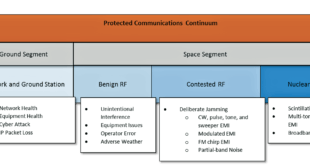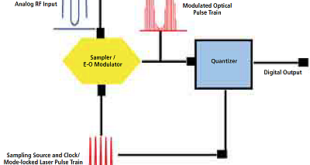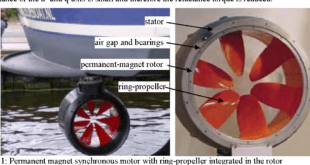Strong IoT device authentication is required to ensure connected devices on the IoT can be trusted to be what they purport to be. Consequently, each IoT device needs a unique identity that can be authenticated when the device attempts to connect to a gateway or central server. With this unique …
Read More »US DOD developing anti-jam technologies for WGS Satellites to counter advanced Russian Electronic Warfare
Military has become highly dependent on satellites for high data rate beyond line of sight communications as well as network centric operations. Satellite communications are also required to support military operations that are becoming more complex as conflict areas grow more dispersed on a global scale. The ever increasing …
Read More »Photonic ADCs have removed the bottlenecks of bandwidth limitations and timing jitter of electronic analog-to-digital converter (ADC)
The performance of digital receivers used in modern military radar, communication, and surveillance systems is often limited by the performance of the analog-to-digital converter (ADC) used to digitize the received signal. Ultrafast ADCs are critical in military applications such as military software-defined radio, radar, and electronic counter-warfare (ECW) that require …
Read More »Militaries race to develop Quantum radar that would render Stealth Aircraft Obsolete, monitor Ballistic missiles to low altitude satellites
The utility of Modern high frequency Radars have become degraded due to innovation in stealth that resulted include unusual shapes that deflect radar waves—like the US B-2 bomber’s “flying wing” design (above)—as well as carbon-based materials and novel paints. China and Russia have since gotten stealth aircraft of their own, …
Read More »Structural electronics to disrupt the automotive and aerospace sectors by replacing dumb components with smart materials, smart skin, load-bearing parts, and e-textiles
The term, structural electronics (SE), refers to a next-generation based electronics technology, which involves the printing of functional electronic circuitries, across irregular-shaped architectures. SE is expected to replace bulky load-bearing structures within a circuitry with smart electronic components that can conform to complex shapes for ensuring optimum space utilization. SE …
Read More »US DOD developing Cryogenic Signal Intelligence (SIGINT) systems for future Electronic Warfare
Cryogenics is the study of the production of extremely cold temperatures and is a field of science that looks at what happens when materials, whether metals or gases, are exposed to very low temperatures. The range of temperature associated with cryogenics does tend to vary but is usually associated with …
Read More »Antennas breakthroughs enabling IoT, 5G, WiFi, Wearables, Military communications, radar, and electronic warfare.
Antennas are our electronic eyes and ears on the world. They play a very important role in mobile networks, satellite communications system, military communications, radars and electronic warfare by transforming a Radiofrequency ( RF) signal, traveling on a conductor, into an electromagnetic wave in free space and vice versa. The …
Read More »DARPA SSPARC developed spectrum-sharing technologies between military radars and communication systems for assured access to contested electromagnetic environment
Spectrum congestion is a growing problem. It increasingly limits operational capabilities due to the increasing deployment and bandwidth of wireless communications, the use of net-centric and unmanned systems, and the need for increased flexibility in radar and communications spectrum to improve performance and to overcome sophisticated countermeasures. Ongoing wireless …
Read More »Propulsion motors are enabling stealthy warships and submarines propelled with an electric propulsion system
Navies of various countries have announced making their warships and submarines propelled with an electric propulsion system. Instead of driving the ship’s propellers directly, diesel engines turn electric generators, which in turn power electric motors that drive the propellers. This arrangement enables diesels to be placed away from the shafts and …
Read More »NATO refocussing on development of Electronic Warfare to match sophiticated capabilites of its adversaries
For NATO forces, the Electromagnetic spectrum (EMS) is an essential part of military operations, so much so that many Allied leaders now see the EME as an operational environment and a part of the battlespace where friendly forces manoeuvre in time, location, and spectrum to create electromagnetic effects in support …
Read More » International Defense Security & Technology Your trusted Source for News, Research and Analysis
International Defense Security & Technology Your trusted Source for News, Research and Analysis









